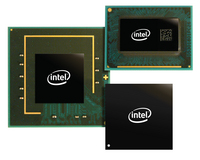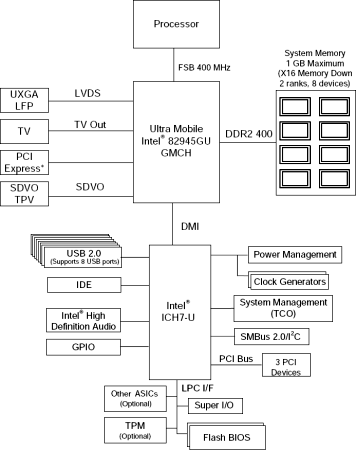Intel launches mobile device chips, roadmap
Apr 18, 2007 — by LinuxDevices Staff — from the LinuxDevices Archive — views At its Beijing Developer Forum this week, Intel confirmed it is shipping an “ultra mobile” chipset for UMPCs (ultra-mobile PCs) and MIDs (mobile Internet devices). It also claimed to be sampling a second-generation mobile processor based on 45nm silicon and “High-K” metal gate transistor technology.
At its Beijing Developer Forum this week, Intel confirmed it is shipping an “ultra mobile” chipset for UMPCs (ultra-mobile PCs) and MIDs (mobile Internet devices). It also claimed to be sampling a second-generation mobile processor based on 45nm silicon and “High-K” metal gate transistor technology.
Intel first shared its Windows-based UMPC vision a year ago, and revealed its Linux-based MID vision yesterday.
Intel's new “UMP2007” platform
 Intel UMP 2007 chipset (Click to enlarge) |
Intel said its “Ultra Mobile Platform 2007” chipset, formerly codenamed “McCaslin,” will ship this year in devices from dozens of companies, including Aigo, Asus, Fujitsu, Haier, HTC, and Samsung. The chipset is based on Intel's A100 and A110 processors (formerly codenamed “Stealey”), a “GU” version of its 945 Express Chipset laptop northbridge, and a “u” version of its ICH7 I/O Controller Hub laptop southbridge.

Intel's Ultra Mobile Platform 2007 diagram
(Click to enlarge)
The two Stealey parts, dubbed A100 and A110, are based on Pentium M cores clocked at 600MHz and 800MHz, respectively. Both have 400MHz FSB (front-side bus) speeds, 512KB of L2 cache, and a 14 x 19mm package. Both are built on 90nm process technology and have a TDP (thermal design power) of 3 Watts.
The 945GU northbridge supports up to 1GB of single-channel DDR2 memory, via a pair of SO-DIMM interfaces. It has a “Gen 3.5” Intel IGP (integrated graphics processor) clocked at 133MHz, an LVDS interface, and a 1-lane PCI Express interface.
Roadmap
Going forward, Intel is sampling a “Silverthorne” mobile device processor based on its industry-leading 45nm silicon process and “High-K” metal gate transistor technologies. Silverthorne will mate to a “Poulsbo” companion chip (integrated northbridge/southbridge), in Intel's second-generation mobile chipset, codenamed “Menlow.”
Interestingly, target markets include not only ultra-mobile and mobile devices, but also desktops, workstations, and servers, illustrating the universal appeal of power-efficiency.
Additional perspective on Intel's IDF Beijing news can be found in an insightful commentary by PC Magazine notable Tim Bajarin, here. Another PC Magazine report on Intel's IDF news today can be found here.
This article was originally published on LinuxDevices.com and has been donated to the open source community by QuinStreet Inc. Please visit LinuxToday.com for up-to-date news and articles about Linux and open source.